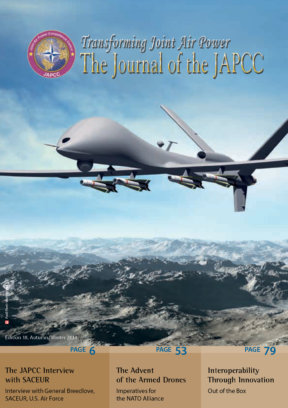Editorial
“Gentlemen we have run out of money. It is time to think.”
Winston Churchill, Prime Minister UK, 1940
This quote is applicable to most NATO nations for the past two decades when governments started to take in the so-called peace dividend and reduced their defence budgets drastically. A lot of thinking has been done how to deal with these budget reductions. But this thinking was always constrained by a purely national approach, with almost no coordination within NATO. This is the reason why NATO still has too many legacy capabilities which never have been used and most likely never will be used in the foreseeable future. Whilst no European nation is able to go to war on its own, in defence policy matters they act on the contrary, consequently keeping up out-dated capabilities, rather than making smart choices. Although Smart Defence and the Connected Forces Initiative sound great on paper, they have so far not generated any urgently needed military capabilities. The time to think is behind us, it is time to act. NATO nations should take a proportionate burden in funding and fielding required capabilities and have the political will to make choices collectively and, if nations act really smart, they can save money.
It’s my pleasure to open the 18th JAPCC Journal. First of all I would like to welcome our new Director, General Frank Gorenc. We are delighted to have him as our new boss. I am also very pleased with the interview from our former Director, General Breedlove, since May the Supreme Allied Commander Europe. The use of armed Remotely Piloted Aircraft (RPA) in operations has already led to heated and intensive discussions. Dr. Mark R. Jacobson stresses that NATO has to begin both informal and formal discussions over what role these RPA (erroneously called ‘drones’) may play in Alliance operations.
This year’s JAPCC Conference theme is ‘Air Power Post-Afghanistan’. The future role of Air and Space Power in NATO might have serious impacts far beyond the military community. The JAPCC has the ambition to facilitate discussion across the entire NATO community. In order to lay the groundwork for the upcoming discussions we produced a ‘Conference Introduction’ (page 42) that can yield thought-provoking and interesting dialogue. Major General Andrew M. Mueller explains that after thirty years of sustained operations the mission of NATO’s E-3A Component is still fully engaged in NATO operations today and capable, ready and relevant for NATO operations of the future (page 27). Commander Tim ‘Fitz’ Fitzpatrick offers a way to work through traditional barriers to international cooperation with Modelling and Simulation. Therefore a unified and standardised M&S position is needed in order to facilitate required standardisation and interoperability (page 79). Other articles cover topics from the modernisation of NATO nation’s Air Transport and Air-to-Air Refuelling fleet, developments in future Joint Helicopter MEDEVAC and Force Protection capabilities, to the F-35 as the back bone of NATO’s future air operations. I’d like to thank all the authors for their contributions which have made this edition worthwhile reading.
A.A.H. (Tom) de Bok
Air Commodore, NE AF
Assistant Director Transformation, JAPCC








